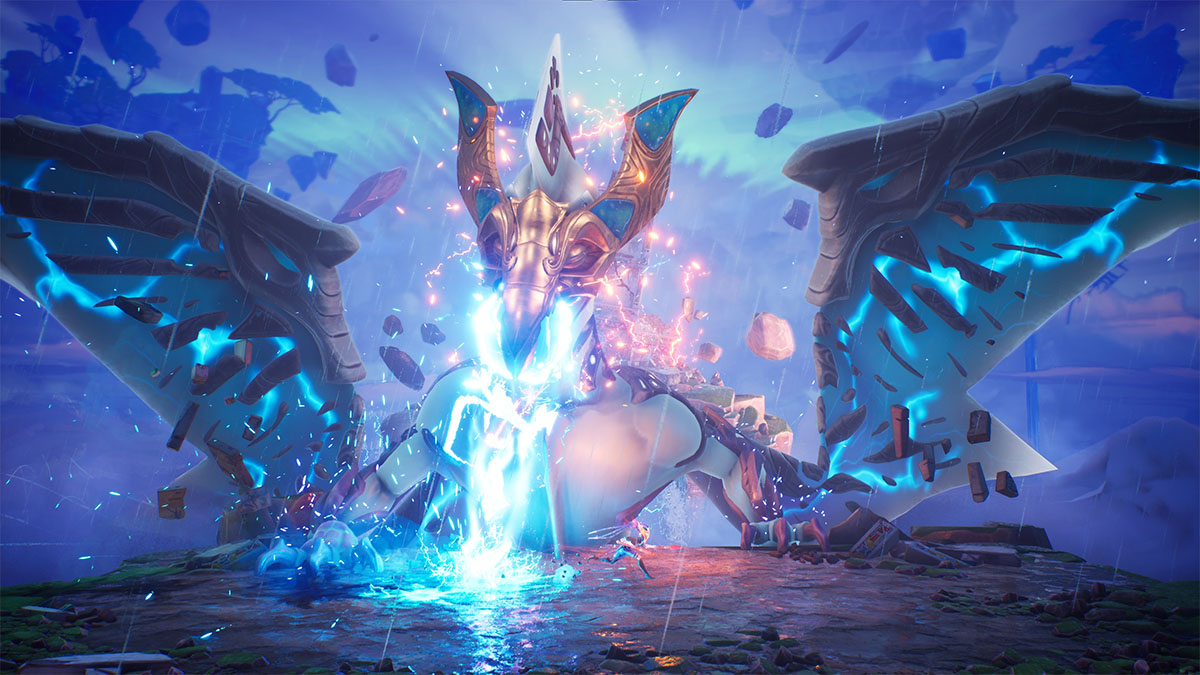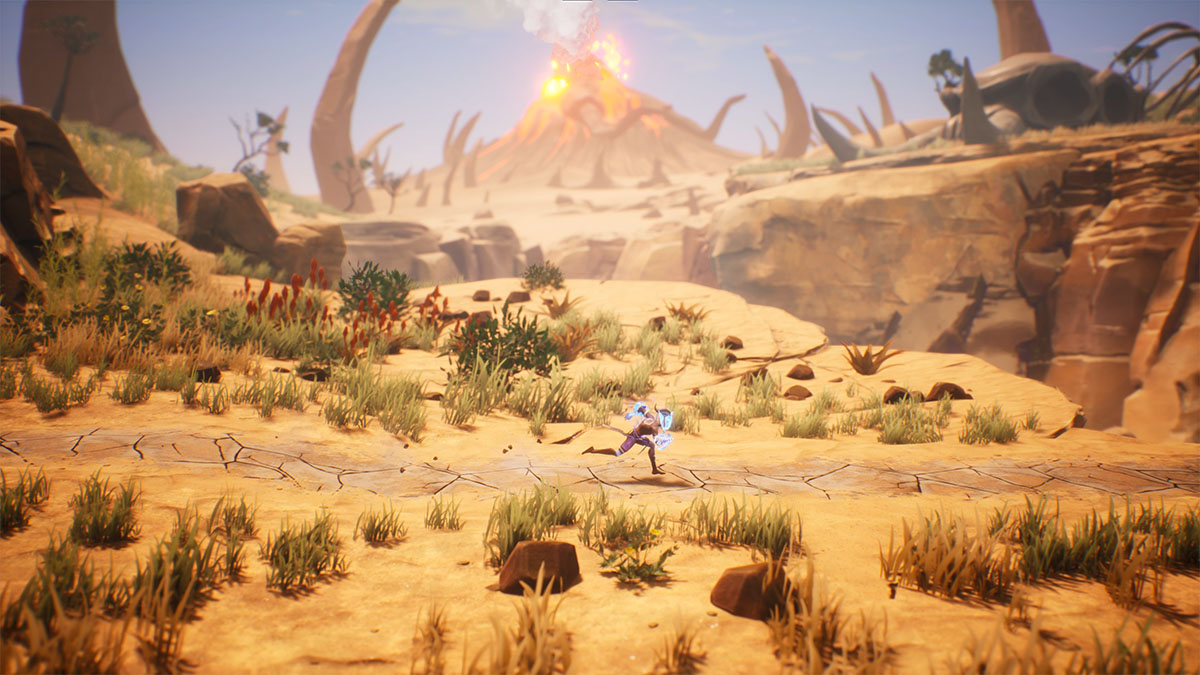Telling stories is one of humankind’s best ways of passing on our history and can be especially helpful when dealing with grief. That concept is at the core of Tales of Kenzera: Zau, a Metroidvania that does double duty as an action game and an emotional journey to overcome the grief of losing a parent, inspired by its lead developer’s own experience of losing his father. It mostly succeeds at both.
A Game and Exercise in Healing, All in One

As Tales of Kezera: Zau opens, we’re introduced to Zubari, a young man in the afrofuturist city of Amani struggling to accept a timeless pain: His father has just passed, and the pain is almost too raw to bear. In an effort to help him cope with his grief, Zubari’s Mama gives him a book his father wrote. The game itself takes place in Zubari’s imagination as he reads his father Baba’s final work, the tale of the Shaman Zau, and his journey to reclaim his father from the God of Death.
Over the course of the game, Zau encounters many trials and faces down dangerous foes, learning important lessons about himself and life. What caught my attention more than anything as I played was how the Metroidvania gameplay style of finding upgrades and abilities occurred parallel to Zau’s (and thus Zubari’s) personal journey.
The more powers Zau obtains, the further he is toward coming to terms with his Baba’s passing. Zau’s companion during this adventure is the God of the Dead himself, who tries to provide the wisdom of ages to the young Shaman. More interestingly, earning each new ability isn’t just a one-and-done animation with a tutorial (though that’s there, too). Instead, each of them is a power held by one of Zau’s Shaman predecessors during some great tribulation. Collecting them is meant not only to empower the young man but to teach him the value of struggle, acceptance, sacrifice, and duty.
The other power-ups in the game are also charged with emotion and meaning, with the most poignant being the Reflection points inside the hollows of great baobab trees. I wanted to seek these out not only because they increase Zau’s maximum health but also because these Reflections offer important narrative moments where Zau comes to a realization about his life with his own Baba. And while there is never a cut to Zubari reading one of Zau’s reflections, it’s hard to imagine these moments without that thought crossing your mind.
In the lead-up to playing the game for review, I was concerned about how my own grief might affect my impressions of it. I approached Tales of Kenzera: Zau with a bit of trepidation, unsure whether it might bring any old wounds to the fore. And it did, but only near the end. My main issue with the game in that respect is that the message of healing and growth is stifled by the gameplay.
Tales of Kenzera: Zau is very similar to Ori and the Blind Forest and its sequel, gameplay-wise. The primary difference is that Tales of Kenzera gives the character more depth with dialogue, and the back-and-forth between Zau and the God of Death fills in the emptier spaces between main objectives. The character work in Tales is also much stronger, if a bit predictable.
I was always more taken by the reflections than I was by the big story beats, as the story beats always came with some gameplay setpiece or were close to some platforming or combat challenge. In other words, playing Tales of Kenzera: Zau was incredibly distracting from its narrative and messaging, much in the same way as the Ori series.
A Fantatsic Metroidvania With Some Glaring Annoyances

Making a Metroidvania game well is incredibly difficult, and while I can confidently say that Tales of Kenzera is a great Metroidvania, it falters in the same way many others do. When it works, though, it’s great fun.
Combat Mastery Is Saftisying
First and foremost is the combat design. Zau has access to two Masks that grant him different attack forms. The Moon is a ranged specialist with a full-screen energy blast for its light attack and a close-range slam with its heavy. The Sun is melee-focused, coming with a three-hit combo for its light attack and a launcher for its heavy attack. Swapping between each form happens at the press of a button, and neither of them is inherently better than the other. One of the earliest back-and-forths you’ll have in the game is running out of moonbeams and needing to switch to Sun while the blasts recharge.
You’ll collect lots of different upgrades to your kit as you play, whether through a short skill tree or through traversal and world abilities, but the core of Kenzera’s combat is the interplay between the Moon and the Sun. There’s a simplicity here that ensures the developers always know what the player has when designing its many combat challenges.
Mastering the combat in Tales of Kenzera: Zau is very satisfying, as it’s easy to grasp, and while it isn’t terribly deep, there’s enough complexity to keep things interesting for the entire playthrough, especially if you purchase a few upgrades.
Level Design Can Get Frustrating
As for the Metroidvania elements, Tales of Kenzera is very much a product of a small but dedicated team. There are only a handful of traversal upgrades, but, as with the combat, offering a smaller number of new powers lets the level design sing more. There’s a fair bit of creativity on display even when you don’t have access to many ways of getting around, and there are enough secrets hidden in earlier parts of the game that you’ll want to come back with new powers to learn what’s hidden behind that uncrossable gap or unbreakable wall.
The only weakness of Tales of Kenzera‘s level design is its reliance on backtracking. Most of the levels you go through have dead-end sections where you’re forced to retrace your steps for a significant distance, to the point of annoyance in some situations. More frustrating is the fact that the game has fast-travel points scattered about the map but never in places where they’d be more convenient. I get that the developers would want to see us overcome platforming challenges in reverse, but if you need to return to early-game areas to hunt for secrets, retreading old ground, even with new abilities, can be tiring.
I would also be remiss not to mention some of the late-game combat challenges, which are just irritating to complete. Between a specific enemy type, a lot of visual noise on the screen, and limited room to maneuver, I found myself enjoying Tales of Kenzera significantly less at its later points than I did early on. The charm of its story or the depth of its message meant little when I was angry at a fight I just threw my head against for fifteen minutes.
Music, Voice Acting, and Performance Are All Wins

My issues with some of the level design and combat challenge decisions aside(which are big problems for me in a game like this), every other part of Tales of Kenzera: Zau lands squarely on its feet. The music, which uses traditional African instrumentation and vocal work, is always fitting for the moment, whether tender or driving. The character writing is phenomenal, especially for Zau and the God of Death, and the various NPCs you meet in the world all have their own stories to tell, even if sometimes they’re a bit predictable.
The voice acting is also top-notch, with special mention going to Abubakar Salim and Tristan D. Lalla as Zau and the God of Death, respectively. Salim’s voice work in the reflection points is probably the strongest in the game, as he channels his own pain of losing his father into Zau’s voice.
Lastly, Tales of Kenzera: Zau is more than technically proficient. It runs like butter at high framerates, comes with a relatively full suite of graphics and accessibility options on PC, and I experienced very few bugs during my playthrough. There were a couple of moments where I would be caught inside geometry or experience some weird physics interaction, but for the vast majority of my time, things went very smoothly.
The Bottom Line

Tales of Kenzera: Zau is a fantastic entry in the increasingly competitive Metroidvania genre. It’s worth your time simply as a great game or as a supplement for whatever emotional pains you might be feeling in real life. It might even be both. No matter your reasons, you’ll find a game worth every second of your time in Tales of Kenzera: Zau.
Pros
- An incredibly solid Metroidvania gameplay loop
- Fast, frenetic combat that’s simple yet deep
- A heartfelt story with fantastic voice acting, music, and environments
Cons
- Sometimes cumbersome level and combat challenge design
- Disconnect between the gameplay and story
- Minor bugs that interfere just enough to be notable







Published: Apr 22, 2024 01:49 pm